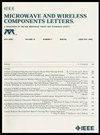采用数字控制人工介质差分传输线的K波段CMOS驻波振荡器
IF 3.3
2区 工程技术
Q2 ENGINEERING, ELECTRICAL & ELECTRONIC
引用次数: 0
摘要
本文介绍了一种基于数字控制人工介质差分传输线的k波段驻波振荡器。该设计结合了恒相位和数字控制宽调谐范围的特性,在相位噪声和调谐范围之间实现了较好的平衡。因此,紧凑的布局和高工作频率是可能的,因为dicad - dtl在这种设计中表现得像谐振器而不是电容器组。该芯片采用标准的0.13- $\mu \text{m}$ CMOS工艺制造,面积为0.035 mm2。它实现了从19.2到21.6 GHz的调谐范围。在1 mhz偏移时,测量到的相位噪声约为−104.7 dBc/Hz。该振荡器包括缓冲器,从1.5 v电源消耗5 mA,分别显示出- 181.8和- 183.3 dBc/Hz的优值(FOM)和FOM $\ maththrm {_{T}}$。本文章由计算机程序翻译,如有差异,请以英文原文为准。
A K-Band CMOS Standing Wave Oscillator Using Digital-Controlled Artificial Dielectric Differential Transmission Lines
This letter presents a K-band standing wave oscillator (SWO) based on digital-controlled artificial dielectric differential transmission lines (DiCAD-DTLs). By combining the unique property of constant phase and digitally controlled wide tuning range, the proposed design achieves a better balance between phase noise and tuning range. A compact layout and high operating frequency are, hence, possible, since DiCAD-DTLs in this design behave like a resonator instead of a capacitor bank. This chip was fabricated in a standard 0.13- $\mu \text{m}$ CMOS process with an area of 0.035 mm2. It achieves a tuning range from 19.2 to 21.6 GHz. The measured phase noise is around −104.7 dBc/Hz at a 1-MHz offset. This oscillator including buffer consumes 5 mA from a 1.5-V supply, demonstrating a figure of merit (FOM) and FOM $\mathrm {_{T}}$ of −181.8 and −183.3 dBc/Hz, respectively.
求助全文
通过发布文献求助,成功后即可免费获取论文全文。
去求助
来源期刊

IEEE Microwave and Wireless Components Letters
工程技术-工程:电子与电气
自引率
13.30%
发文量
376
审稿时长
3.0 months
期刊介绍:
The IEEE Microwave and Wireless Components Letters (MWCL) publishes four-page papers (3 pages of text + up to 1 page of references) that focus on microwave theory, techniques and applications as they relate to components, devices, circuits, biological effects, and systems involving the generation, modulation, demodulation, control, transmission, and detection of microwave signals. This includes scientific, technical, medical and industrial activities. Microwave theory and techniques relates to electromagnetic waves in the frequency range of a few MHz and a THz; other spectral regions and wave types are included within the scope of the MWCL whenever basic microwave theory and techniques can yield useful results. Generally, this occurs in the theory of wave propagation in structures with dimensions comparable to a wavelength, and in the related techniques for analysis and design.
 求助内容:
求助内容: 应助结果提醒方式:
应助结果提醒方式:


